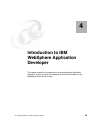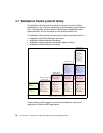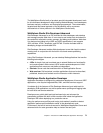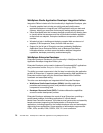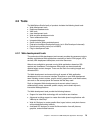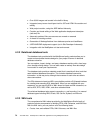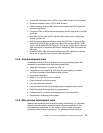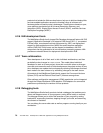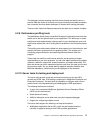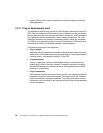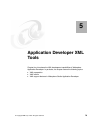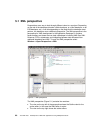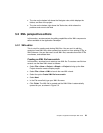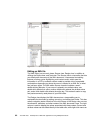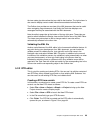76 The XML Files: Development of XML/XSL Applications Using WebSphere Studio
products that include the Web services feature, help you to build and deploy Web
services-enabled applications across the broadest range of software and
hardware platforms used by today's businesses. These tools are based on open,
cross-platform standards such as Universal Description Discovery and
Integration (UDDI), Simple Object Access Protocol (SOAP), and Web Services
Description Language (WSDL).
4.2.6 EJB development tools
The WebSphere Studio family (except Site Developer Advanced) feature full EJB
support (Application Developer v5.0 supports EJB2.0 and EJB 1.1), an updated
EJB test client, an enhanced unit test environment for J2EE, and deployment
support for Web application archive (WAR) files and Enterprise application
archive (EAR) files. Entity beans can be mapped to databases, and EJB
components can be generated to tie into transaction processing systems. XML
provides an extended format for deployment descriptors within EJB.
4.2.7 Team collaboration
Team developers do all of their work in their individual workbenches, and then
periodically make changes to a
team stream. This model allows individual
developers to work on a team project, share their work with others as changes
are made, and access the work of other developers as the project evolves. At any
time, developers can update their work space by retrieving the changes that have
been made to the team stream or by submitting changes to the team stream.
All products of the WebSphere Studio family support the Concurrent Versions
System (CVS) and the Rational ClearCase LT products among others.
Other software configuration management (SCM) repositories can be integrated
through the Eclipse Workbench SCM adapters. SCM adapters for commercial
products are provided by the vendors of those products.
4.2.8 Debugging tools
The WebSphere Studio family products include a debugger that enables you to
detect and diagnose errors in your programs running either locally or remotely.
The debugger allows you to control the execution of your program by setting
breakpoints, suspending launches, stepping through your code, and examining
the contents of variables.
You can debug live server-side code as well as programs running locally on your
workstation.




